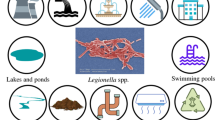Abstract
Illnesses of undiagnosed etiology among researchers exposed to lakes and streams in the Mt. St. Helens blast zone after the 18 May 1980 eruption prompted us to determine the occurrence and potential virulence ofLegionella (Legionnaries' disease bacteria) in aquatic habitats near Mt. St. Helens during the summers of 1981 and 1982. Concentrations ofL. pneumophila, L. micdadei, L. gormanii, L. dumoffii, andL. bozemanii, determined by microscopic counts using direct immunofluorescent staining, ranged from <104 to 105 cells/l in lakes and rivers outside the Mt. St. Helens blast zone while the numbers ofLegionella in aquatic habitats inside the blast zone were from 105 to 107 cells/l.Legionella numbers were consistently highest in North Coldwater and Spirit lakes, which received water from hydrothermal seeps.Legionella pneumophila serogroups 4 and 6 were isolated from North Coldwater Lake in 1981 and from South Coldwater Creek in 1982, indicating that potentially virulent strains ofLegionella persist in aquatic habitats in the blast zone of Mt. St. Helens.
Similar content being viewed by others
Literature Cited
Baross, J. A., Dahm, C. N., Ward, A. K., Lilley, M. D., Sedell, J. R. 1982. Initial microbiological response in lakes to the Mt. St. Helens eruption. Nature296:49–52.
Brock, T. D. 1978. Thermophilic microorganisms and life at high temperatures. New York: Springer-Verlag.
Cherry, W. B., Pittman, B., Harris, P. P., Hebert, G. A., Thomason, B. M., Thacker, L., Weaver, R. E. 1978. Detection of Legionnaires' disease bacteria by direct immunofluorescent staining. Journal of Clinical Microbiology8:329–338.
Fliermans, C. B., Cherry, W. B., Orrison, L. H., Smith, S. J., Tison, D. L., Pope, D. H. 1981. Ecological distribution ofLegionella pneumophila. Applied and Environmental Microbiology41:9–16.
McDade, J. E. 1979. In: Jones, G. L., Hebert, G. A. (eds.), “Legionnaires” the disease, the bacterium and methodology. US Department of Health, Education and Welfare, Center for Disease Control, Atlanta, GA.
Orrison, L. H., Cherry, W. B., Fliermans, C. B., Dees, S. B., McDougal, L. K., Dodd, D. J. 1981. Characteristics of environmental isolates ofLegionella pneumophila. Applied and Environmental Microbiology42:109–115.
Staley, J. T., Lehmicke, L. G., Palmer, F. E., Peet, R. W., Wissmar, R. C. 1982. Impact of Mount St. Helens eruption on bacteriology of lakes in the blast zone. Applied and Environmental Microbiology43:664–670.
Tison, D. L., Pope, D. H., Cherry, W. B., Fliermans, C. B. 1980. Growth ofLegionella pneumophila in association with blue-green algae (cyanobacteria). Applied and Environmental Microbiology39:456–459.
Wissmar, R. C., Devol, A. H., Staley, J. T., Sedell, J. R. 1982. Biological responses of lakes within the Mount St. Helens blast zone. Science216:175–181.
Author information
Authors and Affiliations
Additional information
Technical paper no. 6923, Oregon Agricultural Experiment Station.
Rights and permissions
About this article
Cite this article
Tison, D.L., Baross, J.A. & Seidler, R.J. Legionella in aquatic habitats in the Mount Saint Helens blast zone. Current Microbiology 9, 345–348 (1983). https://doi.org/10.1007/BF01588832
Issue Date:
DOI: https://doi.org/10.1007/BF01588832




